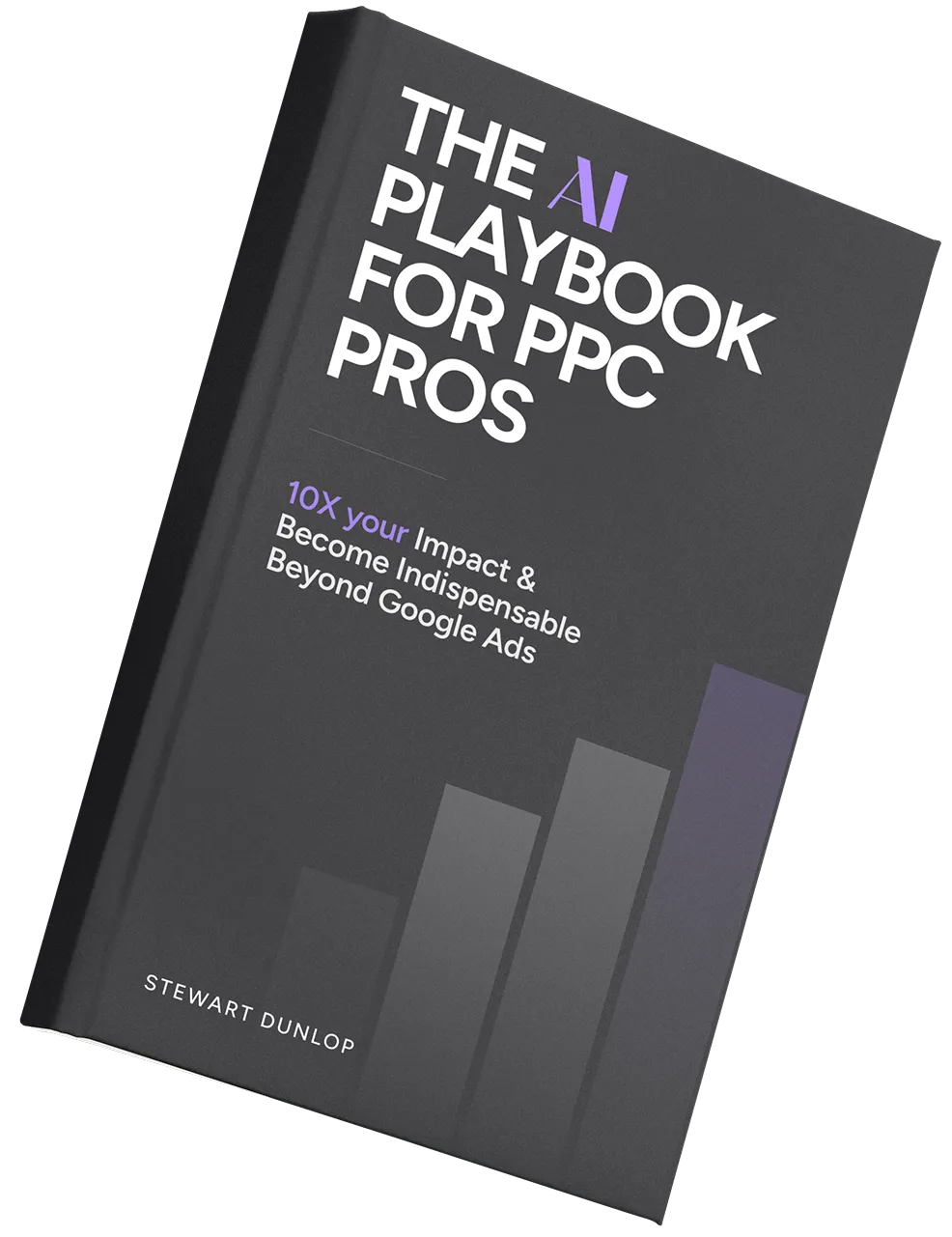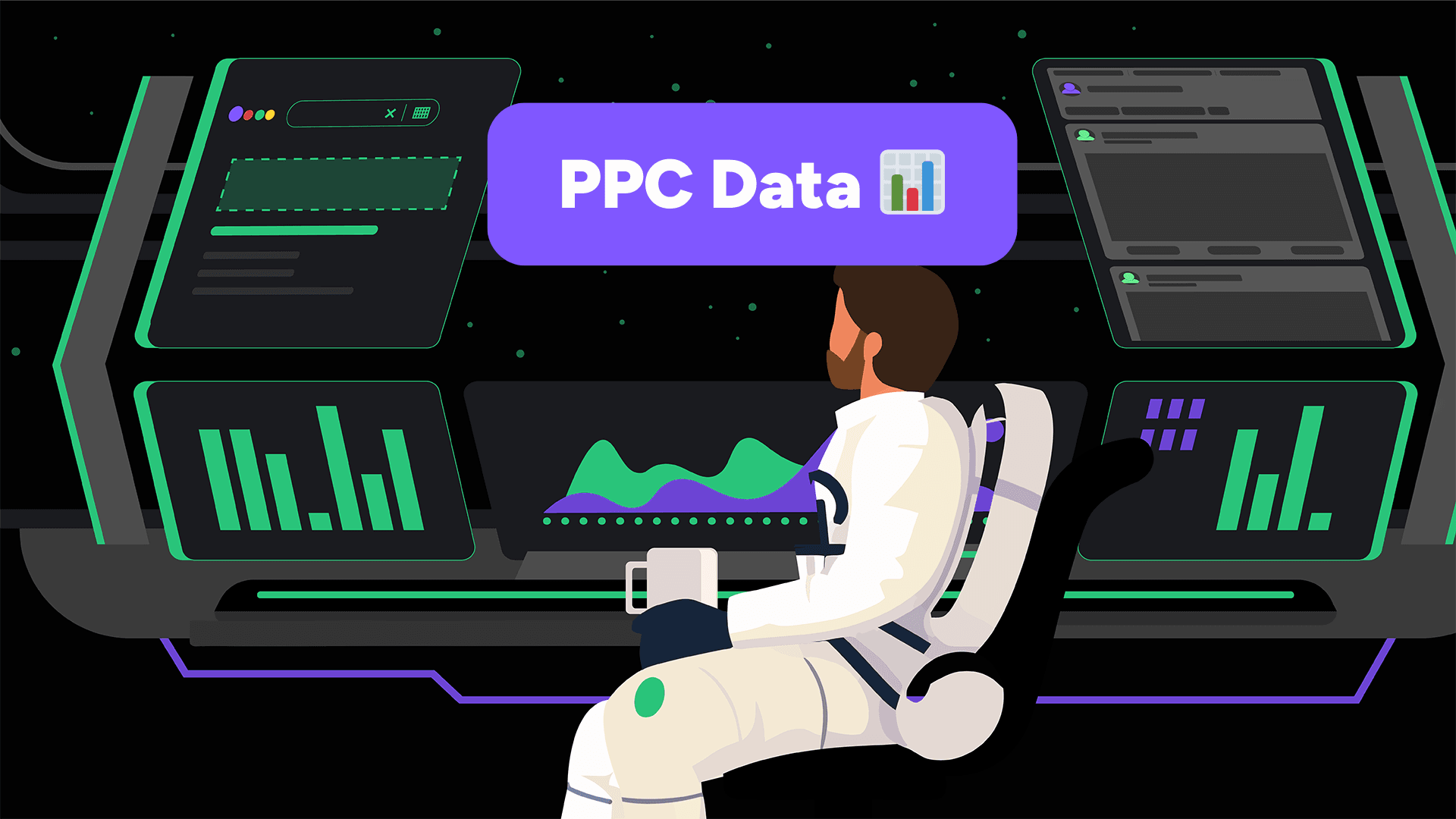
Tons of PPC data is generated from your campaigns which you may not be using to its full extent You can see how people interact with your ads, websites, and offers. And with the right tools, you can even get critical insight into your competitors’ campaigns.
Understanding how to use this information will help you create more effective campaigns.
You can use it to:
- Reduce costs
- Improve conversions
- Decide which ad groups to focus on
- Improve the profitability of your campaigns.
This article will tell you all you need to know about using PPC data.
What Is PPC Data?
PPC Data is the data generated by PPC advertising campaigns. You can use this data to gain insight into all parts of your campaign, including clicks, conversions, costs, and your return on investment.
You can see most of this data in your Google Ads (formerly Google Adwords) dashboard. There are also plenty of third-party tools that show you general PPC data for your industry and your competitors.
Key Takeaways
Understanding PPC data is essential to optimizing your paid ad campaigns and maximizing the impact of your spending.
PPC data helps you evaluate your Google Ads performance through metrics like cost per click (CPC), click-through rate, and conversion rate.
You can analyze your PPC data by following it over time and comparing the performance of different campaigns.
PPC reporting tools in Google Ads or external solutions like Looker Studio help you present your PPC data effectively.
What Can You Use PPC Data For?
PPC account managers can use PPC data to improve the effectiveness of their campaigns.
That’s because the more you know about campaign performance, the more you can optimize your PPC ads to perform better.
Here are four reasons why PPC data is essential.
1. You Can Optimize Your Campaigns
PPC data is essential for optimizing your PPC campaigns. Use it to understand what works and what doesn’t.
For example, digging into your account analytics will show things like the best-performing keywords, offers, landing pages, and more.
You can then roll out the strategies that work across your entire business.
2. You Can Remove Unprofitable Ad Groups
Not all campaigns, ads, or keywords are profitable. This can be the case even if your overall campaign is driving a positive return.
PPC data can highlight which ads and ad groups are underperforming. You can then take steps to improve these elements. Or you can remove them from your campaign entirely by adding them to your negative keywords list.
3. You Can See What Your Competitors Are Doing
PPC competitor analysis tools provide data about the campaigns of other businesses in your industry. You can use this information to power your own campaigns.
Here’s an example of how competitor analysis is useful:
These tools show you the exact keywords multiple competitors are bidding on.
This keyword data is useful because if multiple businesses have been bidding on a term for a long period, this suggests that it is generating results. If your product is similar, this keyword could be a good target.
4. You Can Assess Specific Parts of a Campaign
PPC data lets you dig deep into your campaigns to see data at pretty much any level.
You can see your overall paid search performance. But you can also dig deeper to view specific ad groups, audiences, ad formats, and even summaries of specific assets.
Essential Tools for Analyzing PPC Data
There are many PPC tools available that help you understand your data. But these are the tools that we consider to be the most essential.
Google Ads
Google Ads isn’t just the place where you run your campaigns. It’s also where you get the majority of your PPC data.
The tool shows you everything you need to know about your campaign, including metrics like impressions, click-through rate, conversions, and ROI.
It’s possible to create custom reports so you can see the exact PPC data that is important to your campaign.
Google Analytics
You might not instantly think of Google Analytics as a PPC tool. But it does provide plenty of data that helps measure the effectiveness of campaigns.
The reason it’s useful is that it shows how users behave once they click through to your website.
You can track metrics such as:
- Bounce rate
- Page views per session
- Landing pages
It’s also possible to set up Google Analytics to track conversions. With this in place, you can see how many website visitors take the action you want them to on a specific page.
You can also use your existing Google Analytics data to inform how you set up your paid advertising campaigns.
For example, Google Analytics may show that you have a particular page that converts users from organic search at a high rate.
This page, or an optimized version of it, might be a good option to use as a PPC landing page.
PPC Competitor Analysis Tools
PPC competitor analysis tools are a key source of PPC data. But instead of focusing on the campaigns you run, they highlight data about campaigns run by other companies in your industry.
You can use these tools to see information like:
- The businesses in your industry that use paid ads
- The search queries they bid on
- The keywords that multiple competitors bid on
- Examples of live ads, including their copy and headline
- Estimates of the amount each company spends on paid search ads
You can use this data to inform your own PPC campaigns. For example, you can choose to add keywords that competitors bid on to your campaign.
There are several PPC tools out there that offer competitor analysis features. Two of the most popular include SEMRush and SpyFu.
PPC Data Analysis Tools
PPC analytics and visualization tools take information from multiple sources and let you create reports that highlight this data in an easy-to-read way on a single page.
This is useful for tracking the effectiveness of your campaigns. It’s also useful for reporting to clients or to higher-ups at your company.
Google Data Studio is a useful and free tool for creating reports. Just plug your Google Ads account into Data Studio and then use the graph and charting features to build reports that meet your needs.
The best thing about the tool is that it’s free to use, and there are plenty of templates you can use to create reports quickly.
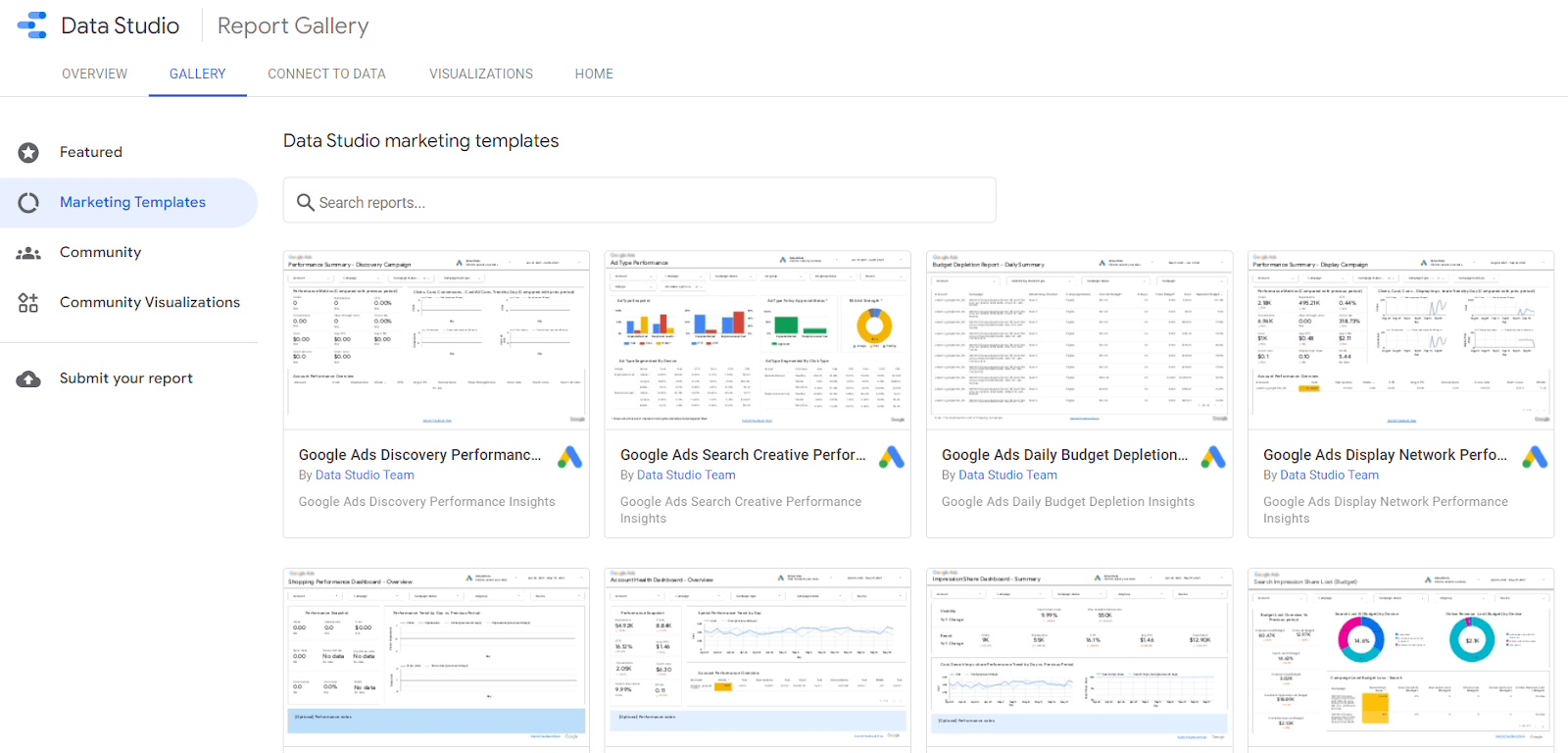
What Kinds of PPC Data Can You See?
There are a ton of metrics available that you can use when running your campaigns. Here are some of the most useful ones.
1. Impression Data
Impressions is the number of times Google shows your ad in the search results. More impressions mean more opportunities to convert customers.
How to Use It:
You’ll typically have low impressions if your budget or Ad Quality Score is too low. Improving either of these factors can result in more people seeing your ads.
Another useful metric is impression share. This is the percentage of impressions you received out of those you were actually eligible to receive.
2. Click Data
Impressions are great, but you really want people to click through to your website.
Clicks are the total number of times someone clicks on your ad, while click-through rate (CTR) shows the percentage of people who click on an ad after seeing it.
How to Use It:
Low CTR happens when people see your ad but don’t want to click on it. This could be due to poor keyword selection, irrelevant offers, or poor ad copy. Fixing any of these factors could increase your CTR.
Competition can also affect CTR. If you’re targeting keywords that many other companies are bidding on, you’ll naturally have a lower CTR than when you bid on a keyword that only shows a single result.
See the image below for an example. SendInBlue likely has a higher CTR on keyword two than on keyword one, simply because in the second image there is only one other competitor.
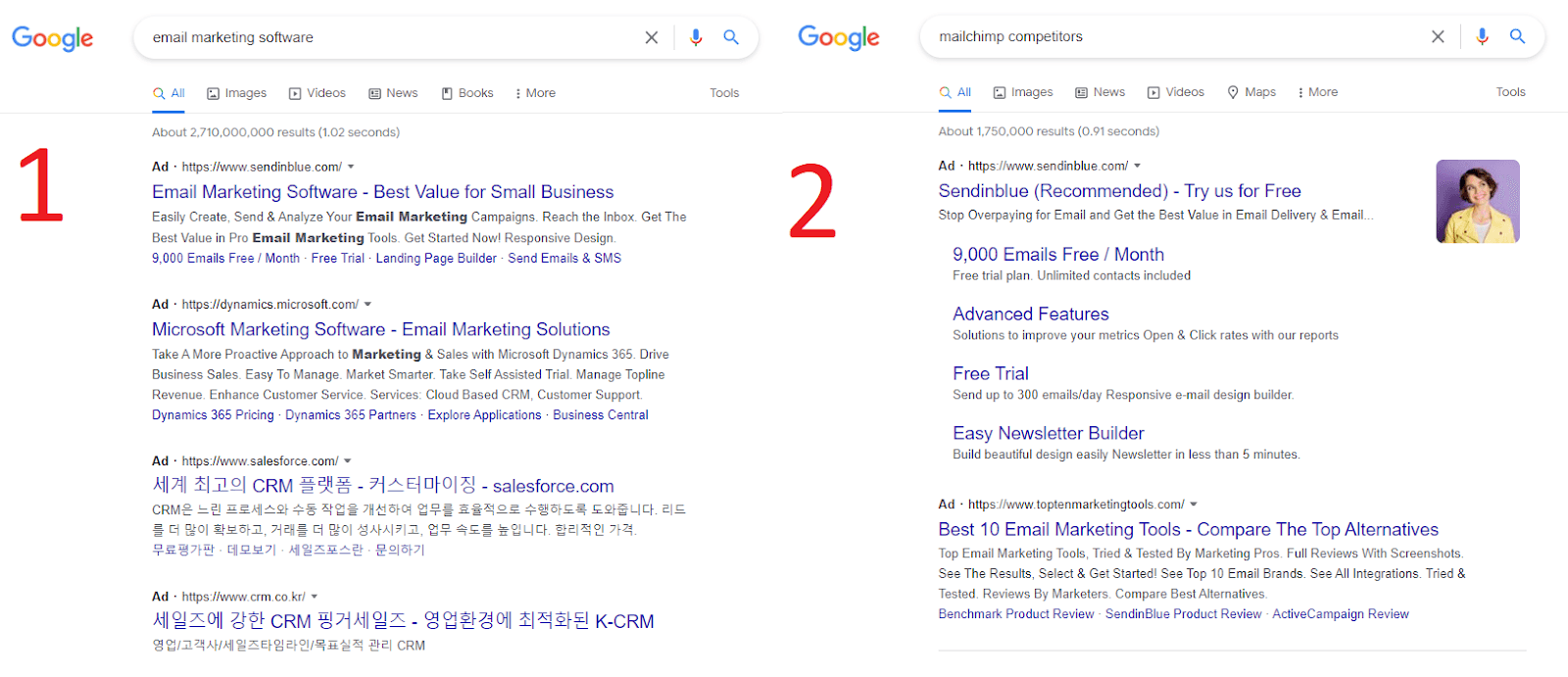
Other factors can affect CTR too. For example, branded keywords typically have a higher CTR than non-branded terms—assuming you are the brand the searcher is looking for.
3. Conversion Data
Conversions are ultimately what defines whether your PPC campaign is successful.
A conversion occurs when someone clicks on your ad and then takes the action you want them to take on your website.
This could be making a purchase, signing up for a free trial, or downloading a lead magnet.
Conversion rate is the percentage of the people who click on your ad that end up converting.
How to Use It:
Look for paid keywords or ads that have a low conversion rate. This could suggest there is a problem with some part of your PPC strategy.
Common reasons for a low conversion rate include:
- Badly set up landing pages
- Technical issues with your website
- A post-click experience that isn’t relevant to the ad
- Offers that aren’t attractive
Improving any of these factors can increase conversions. Dig into your Google Analytics data to see if there are problems with how people use your website.
Other Reasons for Low Conversion Rates
A low (or zero) conversion rate can also be due to issues with PPC tracking. If you haven’t set your tracking pixels up correctly, they won’t know when someone converts.
If you think this might be the case, compare your PPC data to other data about conversions such as sales or email signups. If there are any irregularities, the problem may be your tracking code.
Unfortunately, conversion rate can vary significantly depending on the keyword, industry, and product. This means there is no way to really know if your conversion rate is high or low.
The best thing you can do is look at the data for other similar ads you run and compare it to the ad you think is low.
4. Ad Quality Score
This is a Google metric that shows the quality of your ad. A higher score increases the chances of your ad being shown over your competitors. A high score can also reduce your CPC.
Google uses your expected click-through rate, ad relevance, and post-click experience to calculate your quality score.
How to Use It:
Your Ad Quality Score is a good indicator of the overall effectiveness of your campaign.
If your score is low, consider taking steps to improve your ads and the post-click experience. This could involve redoing your ad copy, coming up with better offers, or optimizing your landing pages.
Doing this won’t just improve your Ad Quality Score; it will also improve the overall effectiveness of your campaigns.
5. Cost Per Action
Cost per action (CPA) is the average amount you spend to convert a customer. This is an essential metric to track because if your CPA is too high, your campaign won’t be profitable.
You can reduce CPA by:
- Improving your landing page so that more people convert
- Targeting keywords that cost less but convert at a similar rate
- Targeting keywords that convert at a higher rate
How to Use It:
Cost per action is useful when you know how valuable an action is. So the first thing to do is work out how much you earn on average when someone converts on your website.
Sometimes this is obvious. If you sell a single product and the aim of your campaign is to get people to buy it, you know exactly how much you earn whenever someone converts.
But things can become more difficult if you sell multiple products, or if your ads are part of a longer sales funnel.
In these cases, you will have to guess the approximate amount a conversion is worth on average.
- Ecommerce stores can look at average basket size and their profit margin.
- SaaS tools that offer a free trial can calculate average customer value alongside the number of customers they expect to convert from a free trial to a paid one.
- Service businesses can calculate the average value of a lead and use this to decide if their ads’ CPA is worth it.
If your CPA is too high, optimizing your campaign can reduce it.
You can take steps such as improving your website so it converts better. You can also simply stop targeting keywords with an unprofitable CPA.
6. Keyword Volume
This is the number of times people search for a keyword each month.
High-volume keywords provide more opportunities for your ads to get shown. Low-volume keywords are often less competitive and can be an opportunity to get your brand in front of searchers at a lower cost.
How to Use It:
Use keyword volume to guide which keywords you bid on. If you have a small budget you may benefit from highly targeted low competition, low volume keywords.
But if you want to generate sales quickly, you’ll need to target higher-volume keywords as these are the ones that generate the most clicks.
You can see keyword volume using the Google Ads keyword tool or via a competitor analysis tool.
The screenshot below shows the top keywords Nike is bidding on and the volume of each one.
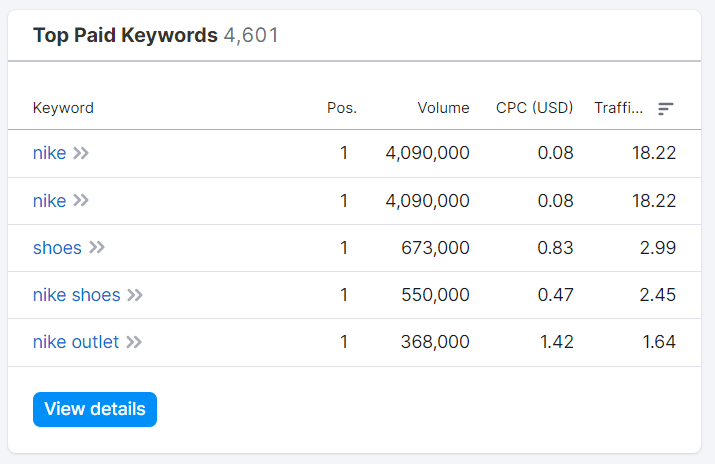
7. Competitor Budget
This is the amount your competitors are spending on ads according to estimates by PPC competitor analysis tools.
The tools generate these estimates by looking at the average CPC for a term over a particular time period, as well as the number of clicks the user generates.
How to Use It:
Use competitor budget data to see how much the companies you are competing with spend on ads. This will show how much you need to spend to compete with them.
You can also use the historical budget data to see patterns that can hint at wider trends.
For example, if all your competitors bump up their ad spend in a particular month, it could mean that this is a good time for generating sales.
But if they have all cut their ad budgets, it could suggest that their campaigns aren’t as effective as they once were.
Below you can see that Nike.com had a big increase in paid ad spend around Black Friday, but it dropped off in the new year.
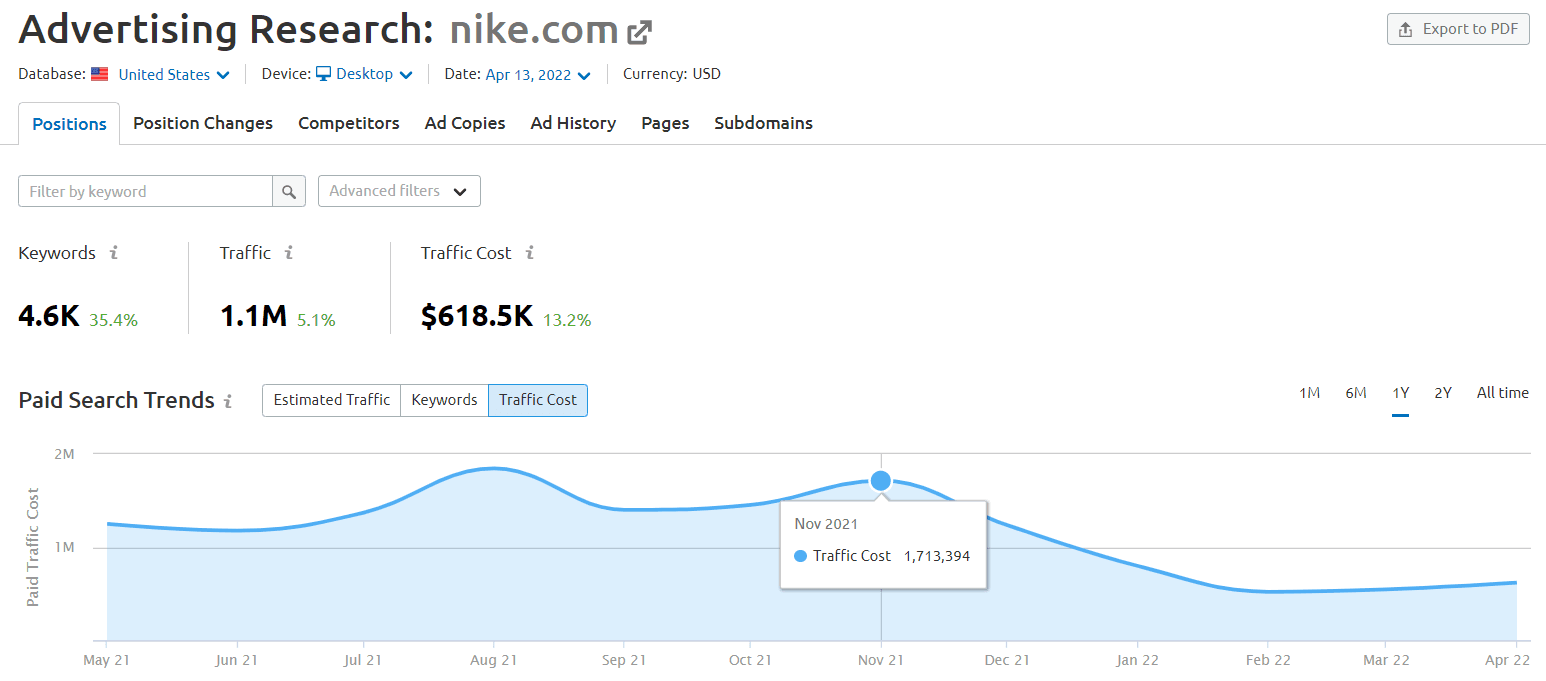
Learning How to Read PPC Data Is Essential If You Manage Campaigns
PPC data contains all the information you need to run successful campaigns. And while it can be overwhelming at first, you must learn to read this data if you plan to run campaigns.
Consider tracking some of the metrics we have listed above. And if you notice any issues, consider taking the steps we have mentioned.
Or Leave PPC to the Experts
Your other option is to leave it to the experts.
At PPC.io, we run campaigns for leading brands in multiple industries. To find out more about our services, get in touch by clicking here.
